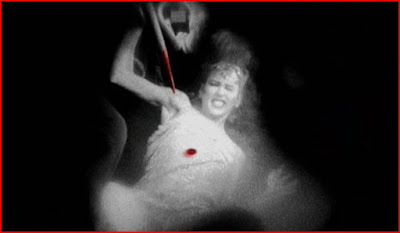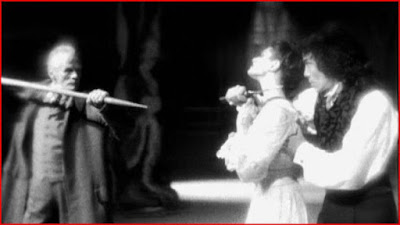 This weekend I invited my friend Wendigo, the vampire-cinema fan, to enter the avant-garde. He was not otherwise disposed; he is disabled in a way that makes it painful for him to sit in a chair without a footrest, so it will be just about impossible for him to see New Moon in a theater. At least he now has our weekly experiments to compensate a little, and this time I hit him with Guy Maddin's black-&-white (with exceptions), silent (with musical score) adaptation of a balletic interpretation of Bram Stoker's story.
This weekend I invited my friend Wendigo, the vampire-cinema fan, to enter the avant-garde. He was not otherwise disposed; he is disabled in a way that makes it painful for him to sit in a chair without a footrest, so it will be just about impossible for him to see New Moon in a theater. At least he now has our weekly experiments to compensate a little, and this time I hit him with Guy Maddin's black-&-white (with exceptions), silent (with musical score) adaptation of a balletic interpretation of Bram Stoker's story.Actually, this was not as alien an experience to him as readers might expect. He is, in fact, the proud owner of a copy of the decade's other great neo-silent horror film, Andrew Leman's The Call of Cthulhu (2005). That small-budget miracle was as stylized, in its way, as Maddin's film is, and in any event as a fan of German Expressionist horror Wendigo isn't averse to stylization -- a good thing in this case.
We are at two removes from Stoker's original. The choreographer, Mark Godden, has broken the novel down into two acts, eliminating the opening scenes with Jonathan Harker in order to begin with Lucy Westenra's seduction, corruption and destruction.
With admirable symmetry, the Harkers are introduced in the second act, which takes place entirely in Europe, beginning at the convent where Jonathan recovers from his ordeal at Castle Dracula. Van Helsing and his gang (the whole crew: Holmwood, Morris and Seward) head there after they torture Renfield into divulging Dracula's plans, and Dracula is already on his way there after Lucy is exorcised and destroyed. Inevitably you lose the multiple-narrator format of the novel, but most adaptations have no use for that either. There are nods to the format; both Lucy and Jonathan keep diaries. The latter is so hot that reading it has Mina ready to bang Jonathan right in the convent. So whose is the singular Virgin's Diary of the title? Search me.
Above, Renfield is a relatively minor player in this version of Dracula who has to be tortured to provide some needed exposition. Below, the magic of dance injects a minor note of nunsploitation into Stoker's classic tale.
Wendigo wasn't as skeptical as some people might be about whether Dracula can be told through ballet, except for the geographic sweep of the climactic hunt. He took for granted that some parts of the story would be lost (including the Piccadilly Circus scene that is always lost in adaptations). He took an expressionistic approach for granted, as well as a romantic approach over Gothic horror. Whether dance can frighten you is debatable, but there are many deeper, arguably more horrific aspects of the story that fit the ballet's romantic format fairly well. Dance definitely draws out the sensual aspect of Dracula's domination of Lucy and Mina, which ties into Maddin's subtext of male sexual anxiety and xenophobia. The sexual awakening of both characters is an obvious subject for dance, and Maddin directs the action to emphasize the power of Dracula and the sort of bullying fear of the men that finds violent expression in their attacks on women and/or vampires.
Pages From a Virgin's Diary is a pretty obvious critique of the misogynist culture from which Dracula emerged. Women are treated as property by vampire and hunters alike, the latter being as outraged by the discovery that Dracula has stolen money from England as by the fact that he has polluted the women's blood. The group transfusion in which the hunters all offer blood to the ailing Lucy, and Seward complains that Holmwood gave her more blood, turns in Maddin's filming into a kind of tribal gang rape. Wendigo gets that same vibe from a later scene when the hunters slaughter Dracula's brides with stakes that are more like lances. The meaning is hard to miss when Maddin captions Holmwood staking a vamp with "Cuckold's Counter-Blow!" And this film strongly suggests that the hunters get perverse thrills from destroying females. That includes dear old Van Helsing, who is last seen stuffing a piece of Mina's petticoat into his vest, having sniffed it earlier when Dracula threw it at him.
Also obvious is Maddin's reading of Dracula as an expression of xenophobia, though I've always felt that critics overstate that angle. Again, title cards make the threat "From the East!" pretty blatant as a poll of black blood spreads west from the Carpathians toward England. The most obvious form the threat takes is the casting of a Chinese dancer, Zhang Wei-Qiang, as Dracula. There's nothing Asiatic about his interpretation of Dracula, but there's no easier way to identify Dracula as The Other than to make him non-European. As a virtuoso dancer he lives up to the romantic ideal of the vampire, but his brandishing of money and his apparent offer to buy Mina's love belies the smooth moves. This is most clear in the Lucy episode, in which it looks like he's vampirized her in order to feed off her after she bites babies. This Dracula is a seductive parasite, and Wendigo thinks that Zhang conveys that well.
Maddin seems to want to eat his cake and have it too, critiquing the politically incorrect patriarchal attitudes he finds in the original text while seeming to confirm the literal threats portrayed by Stoker. This is most perplexing in the Lucy sequence. She's shown as a monstrous baby killer, and yet you can't help but think that there's something wrong with the way the hunters finish her. They take too much pleasure in it, and it struck Wendigo as if they're punishing her, not for killing babies, but for losing her honor to the foreigner. He worries that there's no way anymore to portray the hunters as the sympathetic heroes Stoker meant them to be, because we now automatically see them as patriarchal oppressors. In our less religious age we're less likely to see the situation as putting the women's souls in jeopardy, or vampirism as the Fate Worse Than Death, and more about female sexuality being punished by society. To tell Dracula straight today you would have to deglamourize vampirism totally, or make it clear to the audience that the vampirized person is no longer the person you knew, and can be killed with impunity. Wendigo thinks feminist vampire stories that put positive spins on female empowerment or sexual awakening are perfectly fine -- he couldn't be a fan of urban-fantasy literature otherwise -- but even though he likes Pages From A Virgin's Diary very much he has to note the slightly troubling contradiction.
The hunters wash their hands of Lucy's blood. You be the judge.
Wendigo was impressed by Maddin's selective, symbolic use of color. Blood runs red for the most part, but money glows green and Dracula "bleeds" gold coins when you stab him. The use of color hints at an equivalence of these elements; gold and green paper, arguably, are the blood or life force of the West Dracula has invaded, and we see he's been gorging himself on bills and coins as well as virgins' blood.
Interestingly, Dracula bleeds money at one point to signify his invulnerability (the coins rush back into his wound) before Mina submits to him Nosferatu style, but afterward he bleeds blood like the rest of us. Likewise, Van Helsing's cross is ineffective in Round One, after Dracula, using Mina as a hostage, has convinced him to cover a sun-exposing hole in his castle wall so they can duke it out vampire to hunter.We have our theories about the color of money in Maddin's film, but we're not sure exactly why that cross glows blue in one shot and no others.
A brave vampire this one isn't. A standoff from Maddin's Dracula.
Afterward, after she's bitten, Mina's cross has the expected potency. Wendigo wants to contrast that potency of female empowerment (for Mina resists Dracula a lot more than Lucy did) with the impotence of all the hunters, all of them (not just Holmwood) being cuckolded by the Other running amok among their women. Because she can now withhold what she had given, she can exploit Dracula's dependency in a way the guys couldn't.
Maddin's direction is anything but stagy. He gets his camera all over his sets, filming from all angles and editing quite furiously sometimes. Some of the action scenes are actually well staged and edited, and I suppose it shouldn't surprise us to see dancers capable of taking falls and doing other stunts. He also throws in some horror homages: Van Helsing's arrival at a steamy train station (above) is a nod to The Exorcist (most apropos, Wendigo says) while the business with exposing Dracula to sunlight in his castle is pretty much lifted from Horror of Dracula. But Maddin is naturally more concerned with putting his personal visual stamp on the story, and despite some occasionally arbitrary editing for its own sake, he succeeds admirably. Wendigo has one quibble about the copperplate font Maddin uses for his intertitles, thinking that something more expressionistic was in order for authenticity's sake, but he can live with that. Overall, he recommends it to vampire buffs who may have steered clear of the high concept. It's a worthy addition to the vampire-cinema canon.
And here's a French-language trailer, uploaded to YouTube by EDDISTRIBUTION. Never mind the words, anyway; it's a silent film.














Well Samuel, I hung with every word, and accessed the brief trailer, and I must say it's most intriguing, essentially because it's yet another Dracula interpretation, this time highly stylized, with the ballet form. But some of the old positions are evident I guess:
ReplyDelete"Pages From a Virgin's Diary is a pretty obvious critique of the misogynist culture from which Dracula emerged. Women are treated as property by vampire and hunters alike...", not to mention male sexual anxiety and xenophobia. i also note the contradictions you speak of, and of the fluid use of the camera. I've seen other Maddens but not this, so my response is to acknowledge the most interesting aspects of this exceptionally-written essay.
wait a minute, Wedigo meets Dracula? this interesting idea, well I mean why not, Dracula meets Frankenstein, Wolf man, The Mummy, men Dracula meets all monsters why not Wendigo.
ReplyDelete